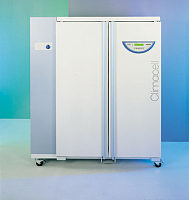人体干细胞成功造出人工牙齿
互联网
哥伦比亚大学医学中心5月25日宣布牙齿再生技术获得新突破,研究人员成功在动物口腔内进行了牙齿再生实验,这意味着未来人们就可将该技术应用于临床实验领域。
杰瑞米·毛(Jeremy Mao)博士负责带领哥伦比亚大学医学中心组织工程学及再生药物实验室的研究人员从事该课题的研究,他们找到一种新的技术,只需在患者口腔内植入一个托架,并将患者体内的干细胞引导至需要牙齿再生的地方,就可以实现真正意义上的“牙齿再生”。用于植入患者口腔的托架将全部采用天然材料制成,并将被放置在失去牙齿的牙洞内。在生长的过程中,该托架将与其周围的牙洞组织逐渐融合,甚至还会令牙周韧带及齿槽骨再生。而这些正是传统种牙方法所无法带来的。
目前传统牙科手术,通过普通外科手术将牙齿种植到患者口腔内的过程仍然令人触目惊心。牙医通常将一个附着牙齿的钛制锥形螺丝直接嵌入患者的颌骨。显然,这种方法将会为患者带来极大的痛苦,而患者的恢复过程也相对较长且较不确定。
目前该技术已经在动物身上进行了成功的实验,这意味着再过不久研究人员就可以在人体上进行实验。
点击此处了解更多
Anatomically Shaped Tooth and Periodontal Regeneration by Cell Homing
Kim K, Lee CH, Kim BK, Mao JJ
【Abstract】Tooth regeneration by cell delivery encounters translational hurdles. We hypothesized that anatomically correct teeth can regenerate in scaffolds without cell transplantation. Novel, anatomically shaped human molar scaffolds and rat incisor scaffolds were fabricated by 3D bioprinting from a hybrid of poly-epsilon-caprolactone and hydroxyapatite with 200-mum-diameter interconnecting microchannels. In each of 22 rats, an incisor scaffold was implanted orthotopically following mandibular incisor extraction, whereas a human molar scaffold was implanted ectopically into the dorsum. Stromal-derived factor-1 (SDF1) and bone morphogenetic protein-7 (BMP7) were delivered in scaffold microchannels. After 9 weeks, a putative periodontal ligament and new bone regenerated at the interface of rat incisor scaffold with native alveolar bone. SDF1 and BMP7 delivery not only recruited significantly more endogenous cells, but also elaborated greater angiogenesis than growthfactor-free control scaffolds. Regeneration of tooth-like structures and periodontal integration by cell homing provide an alternative to cell delivery, and may accelerate clinical applications.







